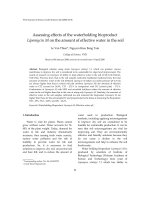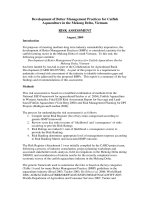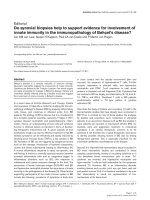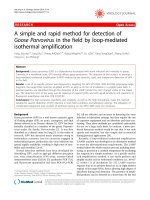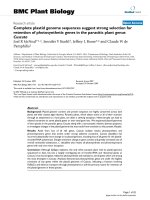Membrane technology for treament of surface water in the mekong delta
Bạn đang xem bản rút gọn của tài liệu. Xem và tải ngay bản đầy đủ của tài liệu tại đây (5.83 MB, 205 trang )
Délivré par l’Université de Montpellier
Préparée au sein de l’école doctorale Sciences
Chimiques Balard (ED459)
Et de l’unité de recherche Institut Européen des
Membranes (IEM)
Spécialité : Chimie séparative matériaux et procédés
Présentée par Duy Linh NGUYEN
MEMBRANE TECHNOLOGY
FOR TREATMENT OF SURFACE WATER
IN THE MEKONG DELTA
Soutenue le 23 novembre 2016 devant le jury composé de
Mme Murielle RABILLER-BAUDRY, Professeur,
ISCR, Université de Rennes I, France
Président du jury
M. Bart Van Der BRUGGEN, Professeur,
Catholic University of Leuven, Belgium
Rapporteur
M. Sylvain GALIER, Mtre de conférences
LGC, Université Toulouse III - Paul Sabatier, France
Rapporteur
M. John PALMERI, Directeur de recherche CNRS,
LCC, Université Montpellier, France
M. André DERATANI, Directeur de recherche CNRS,
IEM, Université Montpellier, France
M. Philippe SISTAT, Mtre de confộrences
IEM, Universitộ de Montpellier, France
M. Franỗois ZAVISKA, Maợtre de conférences
IEM, Université de Montpellier, France
Examinateur
Directeur de thèse
Co-directeur de thèse
Invité
Acknowledgements
This thesis was carried out at Department IP2 (Interface, Physic chemistry, Polymer),
European Membrane Institute (IEM), Montpellier, France, under support of an excellent team
with the participation of many great people who contributed directly and indirectly to this work.
First and foremost, I would like to extend my very deep gratitude to Dr. Andre
DERATANI, my main supervisor, who always beside to support as well as encourage by his
continuous useful advice and immense knowledge that he shared with me throughout the whole
period of three years at IEM. I also place my deep thanks to Dr. Philippe SISTAT as cosupervisor for his precious guidance and scientific assistantship. My special thanks to Dr. Sana
Gassara who works like a supervisor and is always willing to help me during the whole thesis.
I also thank to Dr. John PALMERI for his guidance and support to understand of
transport phenomena in NF membranes and perform the NF results by Nanoflux® software.
Many thanks go to Mme. Valérie BONNIOL and Mr. Eddy PETIT. I am very grateful for
your effort to analyze carefully all my results by HPLC and IC. Working with pilots at the first
time can be a challenging task, but I was lucky to have Mme. Loubna KARFANE, Mr.
Christophe CHARMETTE, Mr. Jean-Pierre AUDINET and Mr. Bruno NAVARRA who guided
and had technical supports to well operate the pilots and get the results presented here.
I would like to show my gratitude to Prof. Marc CRETIN and Mr. Philippe Falque, who
help a lot to overcome difficulties at the beginning period and never stops encouraging me by
their kindness as well as father-like attitude.
That was actually an interesting gift to meet Dr. Franỗois ZAVISKA at the last PhD
duration when most of work intended for writing thesis, as well as NF and ED coupling
experiments. His comments give assistance to present the coupling experimental results by
logical ways and more important to open new development directions for my work in the future.
I wish to express my sincere thanks to the reviewer of this thesis Prof. Bart Van der
BRUGGEN and Dr. Sylvain GALIER for their effort to revise this thesis and give out wellfounded opinions.
i
I give my warm thanks to all my colleagues whom I had the pleasure to work with during
the realization of PhD. Your help and fruitful scientific discussion that we had together will be
precious baggage in my future science work.
Thanks to 911 project via University of Science and Technology of Hanoi (USTH) that
financed all of living cost during three years in Montpellier. You give me a wonderful chance to
effectuate my dream about doing research at a beautiful developed country, France.
The last but not the least, great thankfulness are sent to my family, my dear friends for
their love and unconditional motivation throughout good and bad times. All my love and
gratitude.
ii
Abstract
Abstract
Access to clean water is one of the most important problems that is encountered
worldwide even in countries as water-rich. For instance, the Mekong Delta (MD)’s coastal
provinces have to face up to alternated flooding and drought periods. Moreover, climate changes
inducing less rainfall and salt water intrusion water severely affect the water quality of the area.
The main sources of pollution come from the human and farming wastes including fish, livestock
and poultry. Pesticide pollution can also be a serious problem in some areas. The deterioration of
water quality in the MD and the lack of access to clean water via safe supply systems in the rural
communes entail an increase of waterborne diseases related to the salinity, the presence of
microorganism and organic pollutants. The study is aimed at investigating the membrane
technology to treat surface water in the MD region in order to produce good drinking water. The
study was focused on brackish waters containing pesticides. Two synthetic model water samples
were chosen as representative of surface waters found in the Mekong Delta. Desalination and
pollutant removal were performed using nanofiltration (NF) integrated with electrodialysis. The
Nanoflux® software was used to explain the experimental performance of two NF membranes
(NF90 and 270). On the other hand, energy consumption of the two coupled processes was also
estimated depending on the quality of water feed. All the data obtained should be used in the
future to design a demonstrator pilot for the family-sized production of drinking water.
Keywords: Membrane technology, water treatment, desalination, pesticide, electrodialysis,
nanofiltration.
iii
Contents
Contents
Acknowledgements ...........................................................................................................................i
Abstract .......................................................................................................................................... iii
Contents ...........................................................................................................................................iv
List of tables ..................................................................................................................................... x
List of figures ..................................................................................................................................xi
List of symbols ............................................................................................................................... xv
General introduction ......................................................................................................................... 1
1
Literature review ...................................................................................................................... 4
1.1
Mekong Delta .................................................................................................................... 4
1.1.1
Administrative overview ............................................................................................ 4
1.1.2
River system ............................................................................................................... 5
1.1.3
The role of surface water source ................................................................................ 6
1.1.4
Some threats towards surface water resource ............................................................ 7
1.1.4.1
Climate change.................................................................................................... 7
1.1.4.2
Flooding ............................................................................................................ 10
1.1.4.3
Impacts of human activity on surface water source .......................................... 11
1.1.5
Surface water quality ................................................................................................ 12
1.1.5.1
Salts ................................................................................................................... 15
1.1.5.2
Physical-chemical parameters ........................................................................... 15
1.1.5.3
Nutrients ............................................................................................................ 17
1.1.5.4
Microbial indicator bacteria .............................................................................. 17
1.1.5.5
Metals ................................................................................................................ 18
1.1.5.6
Pesticides........................................................................................................... 19
1.1.5.7
Target of treatment ............................................................................................ 20
iv
Contents
1.2
Nanofiltration................................................................................................................... 21
1.2.1
Introduction .............................................................................................................. 21
1.2.2
Application ............................................................................................................... 23
1.2.3
Transport through the membrane ............................................................................. 24
1.2.3.1
Exclusion mechanisms ...................................................................................... 24
1.2.3.2
Modeling models of transport ........................................................................... 24
1.2.3.3
Nanoflux® ......................................................................................................... 29
1.2.4
1.3
1.2.4.1
Membrane module ............................................................................................ 31
1.2.4.2
Process design ................................................................................................... 32
Electrodialysis ................................................................................................................. 34
1.3.1
Principle of electrodialysis ....................................................................................... 34
1.3.2
Application of ED in desalination ............................................................................ 35
1.3.3
Factors affecting the performance of ED in desalination ......................................... 36
1.3.4
Transport in ion-exchange membrane ...................................................................... 38
1.3.4.1
Donnan equilibrium .......................................................................................... 38
1.3.4.2
The Nernst – Planck equation ........................................................................... 39
1.3.4.3
Transport number .............................................................................................. 39
1.3.5
Membrane process.................................................................................................... 40
1.3.5.1
Process parameters ............................................................................................ 40
1.3.5.2
Concentration polarization in ED ..................................................................... 42
1.3.6
2
Membrane module and process design .................................................................... 31
Energy consumption in electrodialysis .................................................................... 46
Salt Rejection performance of NF270 membrane .................................................................. 48
2.1
Introduction ..................................................................................................................... 48
2.2
Materials and methods ..................................................................................................... 48
2.2.1
Equipment and filtration protocol ............................................................................ 48
v
Contents
2.2.1.1
Experimental apparatus ..................................................................................... 48
2.2.1.2
Membrane conditioning .................................................................................... 49
2.2.1.3
Filtration experiment ......................................................................................... 50
2.2.2
2.2.2.1
Contact angle .................................................................................................... 51
2.2.2.2
Zeta potential .................................................................................................... 51
2.2.2.3
Pure water permeability .................................................................................... 52
2.2.3
Salt solutions ............................................................................................................ 52
2.2.4
Analytical methods ................................................................................................... 53
2.3
Results and discussion ..................................................................................................... 54
2.3.1
Membrane characterization ...................................................................................... 54
2.3.2
Effect of applied pressure on salt rejections and permeate fluxes ........................... 56
2.3.3
Effect of pH on salt rejections and permeate fluxes................................................. 60
2.3.4
Effect of feed concentration on permeate fluxes and salt rejections ........................ 63
2.4
3
Membrane NF270 .................................................................................................... 50
Conclusions ..................................................................................................................... 66
Removal of pesticides used in the Mekong Delta by nanofiltration ...................................... 69
3.1
Introduction ..................................................................................................................... 69
3.2
Materials and methods ..................................................................................................... 70
3.2.1
Membrane selection and characterization ................................................................ 70
3.2.2
Target pesticides ....................................................................................................... 71
3.2.3
Synthetic Mekong river waters ................................................................................ 72
3.2.4
Analytical methods ................................................................................................... 73
3.2.5
Sorption studies ........................................................................................................ 74
3.2.5.1
Sorption experiment protocol ........................................................................... 74
3.2.5.2
Effect of time on the adsorption........................................................................ 74
3.2.5.3
Adsorption isotherm.......................................................................................... 74
vi
Contents
3.2.6
3.3
3.2.6.1
Experimental apparatus ..................................................................................... 75
3.2.6.2
Separation experiment protocol ........................................................................ 75
Results and discussion ..................................................................................................... 76
3.3.1
Target pesticide properties ....................................................................................... 76
3.3.2
Adsorption of pesticides on NF membrane .............................................................. 78
3.3.2.1
Adsorption kinetics ........................................................................................... 78
3.3.2.2
Amount of pesticide adsorbed .......................................................................... 78
3.3.2.3
Absorption isotherm.......................................................................................... 80
3.3.3
Rejection of pesticides in pure water solution ......................................................... 83
3.3.3.1
Rejection of single solution .............................................................................. 83
3.3.3.2
Effect of trans-membrane pressure ................................................................... 85
3.3.3.3
Effect of coexisting pesticides .......................................................................... 86
3.3.4
Rejection of pesticides in synthetic representative river water ................................ 87
3.3.5
Modeling the pesticide rejection by using the Nanoflux® software ......................... 90
3.4
4
Equipment and filtration protocol ............................................................................ 75
Conclusion ....................................................................................................................... 92
Desalination by electrodialysis ............................................................................................... 94
4.1
Introduction ..................................................................................................................... 94
4.2
Materials and methods ..................................................................................................... 95
4.2.1
Experiment equipment and membranes ................................................................... 95
4.2.2
Electrodialysis experiment ....................................................................................... 96
4.2.3
Test solutions............................................................................................................ 97
4.2.4
Analytical methods ................................................................................................... 98
4.2.5
Data evaluation method ............................................................................................ 98
4.3
Results and discussion ................................................................................................... 100
4.3.1
Factors effect to NaCl removal by electrodialysis ................................................. 100
vii
Contents
4.3.1.1
Effect of concentration .................................................................................... 100
4.3.1.2
Effect of applied voltage ................................................................................. 101
4.3.1.3
Effect of divalent cations ................................................................................ 104
4.3.2
4.3.2.1
Effect of voltage .............................................................................................. 107
4.3.2.2
Effect of flow rate ........................................................................................... 109
4.3.3
4.4
5
Desalination the simulated river water by electrodialysis ...................................... 112
Conclusion ..................................................................................................................... 113
Nanofiltration and electrodialysis coupling ......................................................................... 115
5.1
Introduction ................................................................................................................... 115
5.2
Materials and methods ................................................................................................... 116
5.2.1
5.3
ED – NF integrated membrane process.................................................................. 116
5.2.1.1
ED stage .......................................................................................................... 117
5.2.1.2
NF stage .......................................................................................................... 117
5.2.2
Optimizing the NF process ..................................................................................... 118
Results and discussion ................................................................................................... 118
5.3.1
ED – NF integrated membrane process.................................................................. 118
5.3.1.1
ED performance .............................................................................................. 118
5.3.1.2
NF performance .............................................................................................. 120
5.3.1.3
Water product quality ..................................................................................... 121
5.3.2
Comparison between membrane processes ............................................................ 122
5.3.3
Optimizing the NF process ..................................................................................... 126
5.4
6
Desalination the permeate solution of NF by ED .................................................. 107
5.3.3.1
Effect of recovery on permeate flux ............................................................... 126
5.3.3.2
Effect of recovery on the NF efficiency and energy consumption ................. 127
Conclusion ..................................................................................................................... 134
Conclusion ............................................................................................................................ 136
viii
Contents
Reference ...................................................................................................................................... 140
Appendix ...................................................................................................................................... 151
Rộsumộ en franỗais....................................................................................................................... 155
ix
List of tables
List of tables
Table 1-1: Results of the environmental monitoring in Mekong Delta from 3/2012 - 11/2012 [36]
........................................................................................................................................................ 14
Table 1-2: The concentration of heavy metals in Mekong Delta from 3/2012 - 11/2012 [36] ...... 18
Table 1-3: Comparison of properties between NF, RO and UF [4] ............................................... 22
Table 2-1: Bulk Diffusion Coefficients and Stokes-Einstein and Pauling Radii of ions [98]. ...... 52
Table 2-2: Calibration curves for measurement of salt concentrations from ion conductivity ...... 53
Table 2-3: The normalized membrane charge density (ξ) and the effective membrane thickness
(Leff) for each membrane – salt pair are calculated by Nanoflux® simulation ............................... 58
Table 2-4: The osmotic pressure and ionic strength of salt solutions in different concentration .. 64
Table 3-1: The characteristics of the membrane used in this study ............................................... 71
Table 3-2: Composition of the synthetic water samples used in the experiment studying the
influence of coexisting inorganic salts ........................................................................................... 72
Table 3-3: The MS quantification parameter and the detection limit of the pesticides used ......... 73
Table 3-4: The molecular structure and physicochemical properties of the target pesticides ....... 77
Table 3-5: Comparison of Langmuir and Freundlich adsorption isotherm models ....................... 81
Table 3-6: Ion rejection (%) results in the absence and presence of pesticides and pure water flux
increase after each experiment ....................................................................................................... 89
Table 3-7: The summary result of the pesticide rejection modeling by the Nanoflux® software .. 91
Table 4-1: The characteristics of the PCA membranes .................................................................. 96
Table 4-2: The composition of the permeates in NF processes ..................................................... 97
Table 5-1: Concentration of ions in water product of the two integration processes ................... 122
Table 5-2: Rejection performance and energy consumption to treat two simulated river waters by
different coupling of NF and ED.................................................................................................. 124
Table 5-3: The ion concentration in the permeate of the Med50 filtration experiment ............... 131
Table 5-4: The ion concentration in the permeate of the Max50 filtration experiment ............... 132
x
List of figures
List of figures
Figure 1-1: The Mekong River Basin [10] ....................................................................................... 4
Figure 1-2: Maps of river systems and canal networks in the MD [10]........................................... 5
Figure 1-3: Mean lower low waters (Zmin) at Tan Chau Station and Chau Doc Station from 1985
to 2015 .............................................................................................................................................. 9
Figure 1-4: Effects of drought and saltwater intrusion production on residents ............................ 10
Figure 1-5: Severe floods at Tan Chau district [26] ....................................................................... 11
Figure 1-6: Map of sampling points in Tien River and Hau River [36]......................................... 13
Figure 1-7: Schematic drawing of dead-end mode and mode cross-flow of operation ................. 32
Figure 1-8: Schematic drawing of some cross-flow operations: (a) co-current; (b) cross-flow; (c)
counter-current; (d) perfect mixing. ............................................................................................... 33
Figure 1-9: Process configuration for single pass system and recirculation system ...................... 33
Figure 1-10: Principle of electrodialysis process [63] ................................................................... 35
Figure 1-11: Resistances which apply in a cell pair ....................................................................... 41
Figure 1-12: Concentration profiles of the cations in the boundary layer at the surface of a cation
exchange membrane during ED process ........................................................................................ 43
Figure 1-13: Schematic drawing of a R (= U/I) versus the reciprocal current ............................... 46
Figure 2-1. Schematic diagram of the NF pilot .............................................................................. 49
Figure 2-2: The photo of a water drop on the NF270 membrane surface ...................................... 54
Figure 2-3: Zeta potential of the NF270 membrane as the function of pH .................................... 55
Figure 2-4: The plot of the pure water flux as the function of applied pressure ............................ 55
Figure 2-5: The rejection of salt solutions as the function of applied pressure at pH 6 ................. 56
Figure 2-6: The rejection of the four salts as a function of the permeate flux for NF270 at
concentration of 10-2 mol/L at pH 6 (Nanoflux® simulation uses Lp = 15.8 L/m2.h,
= 1 and
rp = 0.535 nm)................................................................................................................................. 58
Figure 2-7: The permeate flux of salt solutions as the function of applied pressure at pH 6. ........ 59
Figure 2-8: The permeate flux as the function of trans-membrane pressure at pH 6 of salt
solutions: a) NaCl, b)Na2SO4, c) CaCl2, d) MgSO4. Nanoflux® simulation (data experiment):
solid blue (star), pure water; solid black (square), salt solution. .................................................... 60
Figure 2-9: The effect of pH on rejections of cations (a) and anions (b) by NF270 (10-2 mol/L and
5 bar) .............................................................................................................................................. 61
xi
List of figures
Figure 2-10: The effect of pH on the permeate flux for different salt solutions (10-2 mol/L and 5
bar) ................................................................................................................................................. 62
Figure 2-11: Effects of feed concentration on the permeate flux for different salts (a) NaCl, (b)
Na2SO4, (c) CaCl2 and (d) MgSO4 (pH 6) ..................................................................................... 64
Figure 2-12: Effects of feed concentration on salt rejections: (a) NaCl, (b) Na2SO4, (c) CaCl2 and
(d) MgSO4 (pH 6) ........................................................................................................................... 65
Figure 3-1: Adsorption kinetics of the three studied pesticides on NF270 (a) and NF90 (b). ....... 78
Figure 3-2: Adsorbed amount of pesticides on NF membranes from single solute system and from
mixtures (Fen: fenobucarb; Iso: isoprothiolane; Pre: pretilachlor) ................................................ 79
Figure 3-3: Plot of the pesticides loading on the membrane against the pesticide equilibrium
concentration in the liquid phase. ................................................................................................... 80
Figure 3-4: The pesticide adsorbed amount as a function of logKow ............................................. 83
Figure 3-5: Rejection of the pesticides in single solution using NF 270 and NF90 membranes
with the following operating conditions fenobucarb (Fen) and isoprothiolane (Iso) concentration
= 300 µg/L – pretilachlor (Pre) concentration = 1000 µg/L, pressure 11 bar, the number upper
columns is the permeate flux (L/m2h)) ........................................................................................... 84
Figure 3-6: Pesticide rejection at different pressures applied in the case of (a) NF270 and (b)
NF90 membranes. .......................................................................................................................... 85
Figure 3-7: The permeate flux of pesticide solutions at different pressures applied in the case of
the (a) NF270 and (b) NF90 membranes. ...................................................................................... 86
Figure 3-8: Rejection of pesticides from single solution and mixed solutions at a pressure 11 bar
by (a) NF270 and (b) NF90 membrane (the number upper columns is the permeate flux (L/m 2h))
........................................................................................................................................................ 87
Figure 3-9: Pesticides rejection by (a) NF270 and (b) NF90 membrane ....................................... 88
Figure 4-1: Schematic of the batch recirculation mode ED system used in this study .................. 95
Figure 4-2: The ratio of the diluate conductivity as a function of time for different feed
concentration at 5V ...................................................................................................................... 100
Figure 4-3: The kinetic constant and the energy comsumption of the desalination process as a
function of feed concentration...................................................................................................... 101
Figure 4-4: Effect of the applied voltage on the ED process for different feed concentrations (a)
0.05 mol/L, (b) 0.1 mol/L, (c) 0.25 mol/L ................................................................................... 102
Figure 4-5: The rate constant of the desalination process as a function of applied voltage ......... 103
xii
List of figures
Figure 4-6: The energy comsumption of the desalination process as a function of applied voltage
...................................................................................................................................................... 104
Figure 4-7: The ratio of the diluate conductivity as a function of time for different concentration
of (a) Ca2+ and (b) Mg2+ in 0.1 mol/L NaCl solution ................................................................... 105
Figure 4-8: The rate constant of the desalination process in different feed solution composition
...................................................................................................................................................... 106
Figure 4-9: Effect of the applied voltage on the ED process for different NF permeate waters: (a)
permeate 1, (b) permeate 2 and (c) permeate 3 ............................................................................ 108
Figure 4-10: The rate constant of the desalination process as a function of the applied voltage . 109
Figure 4-11: Effect of the flow rate on the ED process at 15 V for different NF permeate waters:
(a) permeate 1, (b) permeate 2 and (c) permeate 3 ....................................................................... 110
Figure 4-12: The rate constant of the desalination process as a function of the flow rate ........... 111
Figure 4-13: The energy consumption of the desalination process as a function of the flow rate
...................................................................................................................................................... 112
Figure 4-14: The ratio of the diluate conductivity as a function of time for different simulated
samples ......................................................................................................................................... 113
Figure 5-1: The schematic diagram of the coupled process with the maximum and median
concentration solutions ................................................................................................................. 116
Figure 5-2: The reduction of conductivity and ion concentration in (a) the median (b) the
maximum ED diluate as a function of time.................................................................................. 119
Figure 5-3: The rejection of ions and pesticides by NF process with NF270 of the median
solution in comparison between with or without ED pretreatment stage .................................... 120
Figure 5-4: The rejection of ions and pesticides by NF process with NF90 of the maximum
solution in comparison between with or without ED pretreatment stage. ................................... 121
Figure 5-5: The experimental permeate flux of the two feed solutions as a function of recovery
...................................................................................................................................................... 127
Figure 5-6: The energy consumption and conductivity of the feed and permeate as a function of
recovery for a) the Med50 and b) Max50 .................................................................................... 128
Figure 5-7: The rejection of ions as a function of recovery for a) the Med50 and b) Max50...... 129
Figure 5-8: The energy consumption and concentration of Cl- and Na+ ion in the permeate as a
function of recovery for a) the Med50 and b) Max50 .................................................................. 130
xiii
List of figures
Figure 5-9: The rejection of pesticides as a function of recovery for a) the Med50 and b) Max50
...................................................................................................................................................... 133
xiv
List of symbols
List of symbols
Latin letters
A
effective membrane area
m2
ai
activity of i
-
Ci
concentration of i in bulk solution
mol/m3 or (mol/L)
cim
concentration of i in the membrane
mol/m3
Di
diffusion coefficient of i in bulk solution
m2.s-1
Dim
diffusion coefficient of i in membrane
m2.s-1
dw
density of water at 25°C
g/L
E
electric field strength
-
Edes
energy consumption for a desalination process
KWh.m-3
Ep
energy consumption for a pump
KWh.m-3
F
Faraday constant
-
I
electric current
A
i
current density
A.m-2
ilim
limiting current density
A.m-2
Ji
molar flux density of i
mol-1.m-2.s-1
Jv
volume flux density
L.h-1.m-2
k2f
Donnan co-ion partition coefficient
-
kB
Boltzmann constant
J.K-1
ki
partition coefficient of i
-
Ki,c
convective hindrance factors of i
-
Ki,d
diffusive hindrance factors of i
-
kires
residual partition coefficient
-
leff
effective active NF membrane layer thickness
µm
Lp
effective water permeability
L.h-1.m-2.bar-1
Lp°
pure water permeability coefficient
L.h-1.m-2.bar-1
m
weight of permeate solution
g
N
number of cell pairs
-
np
number of pores
-
ΔP
pressure difference
bar
xv
List of symbols
ΔPe
effective pressure difference
bar
Q
flow rate
m3/h
R
ideal gas constant
J.mol-1.K-1
R
Rejection
none or %
Ram
resistance of the anion exchange membrane
Ω
Rcc
resistance of the concentrate compartment
Ω
Rcm
resistance of the cation exchange membrane
Ω
Rcp
resistance of a cell pair
Ω
Rdc
resistance of the diluate compartment
Ω
Re
resistance of the electrode
Ω
ri
ion radius
nm
rp
pore radius
nm
Rst
apparent resistance of the total membrane stack
Ω
T
absolute temperature
K
T
limiting transmission coefficient
-
t
operating time
h
ti
transport number of i
-
U
electric potential difference
V
V
solution velocity vector
m/s
x, Δx
thickness of the membrane
m
Xm
effective membrane charge density
mol/l
zi
electrochemical valence of i
-
Subscripts and Superscripts
1
counter ion
2
co-ion
b
bulk
bl
boundary layer
c
concentrate
d
diluate
e
electrode
xvi
List of symbols
f
feed
i
ith component
m
membrane
mig
migration
p
permeate or pore
s
solute or salt
S
Stokes
Greek letters
γim
effective activity coefficient of i in the membrane
-
µi
chemical potential of i
-
µi°
chemical potential in a given standard state
-
δ
thickness of the boundary layer
nm
ΔΠ
osmotic pressure difference across the membrane
bar
ΔφD
Donnan potential
V
ε
surface porosity
-
ζ
current utilization
-
η
current efficiency or pump efficiency
-
ή
dynamic viscosity
Pa.s
κ
electro-viscosity coefficient
-
ξ
normalized membrane charge density
-
ρ(x)
local ion charge density of the membrane
-
σ
osmotic reflection coefficient or conductivity
- or mS/cm
τ
pore tortuosity
-
υi
stoichiometric coefficient of i
-
φ
electric potential in membrane
V
Φi
steric hindrance partition coefficient of i
-
Acronyms
ACS
American Chemical Society
ASS
Acid sulfate soils
xvii
List of symbols
BOD
Biological oxygen demand
COD
Chemical oxygen demand
DI
deionized
DO
Dissolved oxygen
EC
European Commission
ED
Electrosialysis
ENP
Extended Nernst–Planck
ES
steric-hindrance model
ESI
electrospray ionization
Fen
Fenobucarb
GCE
good co-ion exclusion
GDP
gross domestic product
HET
hindered electro transport model
HPLC
high performance liquid chromatography
IC
Ion chromatography
Iso
Isoprothiolane
LC
liquid chromatography
MD
Mekong Delta
MF
Microfiltration
MOH
Ministry of Health of Viet Nam
MONRE
Ministry of National Resource and Environment of Viet Nam
MRM
multiple reaction monitoring
MS
mass spectrometry
MSF
Multistage flash distillation
MWCO
Molecular weight cut off
NF
Nanofiltration
Pre
Pretilachlor
QCVN
National technical regulation
RO
Reverse osmosis
SEC
specific energy consumption
TDS
Total dissolved solids
TFC
thin film composite
xviii
List of symbols
THM
trihalomethane
TMS
Teorell-Meyer-Sievers model
TOC
total organic carbon
TSS
Total suspended solids
UF
Ultrafiltration
VND
Vietnam Dong
WCA
water contact angle
WRI
World Resources Institute
xix
General introduction
Chapter 0 General introduction
General introduction
Access to clean water is one of the most important problems that is encountered
worldwide even in water-rich countries. For instance, the Mekong Delta (MD) owns abundant
surface water source with a relatively high density network of rivers and canals. However, this
region has to face up to alternating flooding and drought periods and climate change inducing
less rainfall and salt water intrusion severely affects the water quality of the area. Moreover, the
main sources of pollution come from human waste and waste from the fish, livestock and poultry
farming. Pesticide pollution can also be a serious problem in some areas. Thus, water quality
required for domestic and human drinking purposes is not guaranteed by a direct delivery. To
meet the requirements of water quality, surface water must be treated by an effective process that
should remain in accordance with water production cost. These two key issues need to be
addressed urgently.
In general, rural people have traditional habits for using water, like containing water in
large tanks, using aluminum for flocculation and subsequent boiling before drinking. This
treatment can remove suspended particles, iron and microbial contamination, but it is not likely to
reduce salinity and pesticide residues. For instance, all of six samples taken from household tanks
after flocculating in Thoai Son in June 2012 were contaminated by pesticides, exceeding the
European Commission (EC) drinking water guideline values for total pesticides [1]. Toan et al.
[2] pointed out that the pesticides were detected in the samples of boiled aluminum-treated water
taken from surface water by households. The concentration of some of them even increases
because of the boiling step.
Regarding the water supply stations, the treatment process is more technical. Firstly, a
chemical treatment step with aluminum is applied to surface water to remove suspended particles.
After that it is treated by rock and sand filters in combination with disinfection (chlorine).
Finally, the treated water is generally stored in water towers from where it is distributed to the
connected households. However, the survey of Wilbers [3] revealed that this treatment was
inefficient on Cl- levels since the Cl- concentration in piped-water is similar to that in untreated
surface water. Until now, there has not been any announcement about the residue of pesticides in
piped-water. Although some stations have applied treatment technology through filtering by
active coal to remove organic compounds, it is very difficult to eliminate completely these
pollutants from surface water, due to the lack of good operation and maintenance.
1
Chapter 0 General introduction
Moreover, water production costs are also a great obstacle to access to clean water for
rural people. For example, the percentage of households using piped-water for domestic and
drinking purposes is very low, accounting around 28.47 % in the survey of Wilbers et al. [3] for
the rural areas of Can Tho, Hau Giang, and Soc Trang Provinces. The reason for this problem not
only comes from water quality, but also financial reasons. Particularly, 10.53 % of households
with possible access to piped-water prefer not to connect to the water supply station because of
high water delivery cost. The connection fees in the rural areas is around 1,000,000 VND (ca. 40
EUR in 2016), while reported monthly earnings of households is just 500,000–5,000,000 VND
(ca. 20 – 200 EUR in 2016). The other households (61%) had no possible access to piped-water,
since a water supply station was not present or was not operational. Therefore, poor people
cannot use piped-water and are forced to utilize other water sources with very low quality, such
as rainwater or groundwater.
To solve these problems, we propose applying membrane technology to treat surface
water in the MD. Membrane technologies provide effective and lasting solutions for adequate
supplies of water of suitable quality to meet human, environmental and industrial needs. There
are two basic types of membrane separation processes; pressure-driven and electrically-driven
[4].
Pressure-driven technologies include, in order of decreasing permeability: microfiltration
(MF), ultrafiltration (UF), nanofiltration (NF), and reverse osmosis (RO). MF and UF often
serve to remove large organic molecules, large colloidal particles, and microorganisms. MF
performs as a porous barrier to reduce turbidity and some types of colloidal suspensions. UF
offers higher removals than MF, but operates at higher pressures. In wastewater reclamation, MF
or UF might provide a suitable level of treatment. In drinking water treatment, MF or UF might
be used in tandem with NF or RO to remove coarser material so that fouling of the less
permeable membranes is minimized [4]. The most commonly used process for the production of
drinking water is RO, but NF is now emerging as a viable alternative to conventional water
treatment because it can operate at lower pressures and higher recovery rates than RO systems.
NF is also cost effective in many groundwater softening applications where the incoming
turbidity is low [5].
However, in desalinating saline water, such as sea water and brackish water, containing
mainly sodium chloride, there is a problem when NF is employed. NF enables achieving greater
than 90% removal of divalent and polyvalent ionic species from aqueous solution, but can
2



